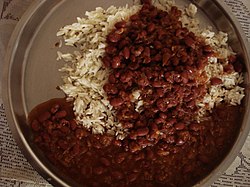Rajma
Rājmā[2] [raːdʒmaː] (Hindi: राजमा, Urdu: راجما), also known as rajmah, rāzmā, or lal lobia, is a vegetarian dish, originating from the Indian subcontinent, consisting of red kidney beans in a thick gravy with many Indian whole spices, and is usually served with rice. It is a part of regular diet in India, Nepal, Bangladesh and Punjab province of Pakistan.[1] The dish developed after the red kidney bean was brought to the Indian subcontinent from Mexico.[3] Rajma chawal is kidney beans served with boiled rice.
 Rajma served with boiled rice from India. | |
| Alternative names | Razma, Laal Lobia |
|---|---|
| Place of origin | Indian subcontinent |
| Region or state | India, Nepal, Bangladesh, Pakistan[1] |
| Associated national cuisine | India |
| Main ingredients | Kidney beans |
| 100 grams of boiled Rajma beans contain 333 calories kcal | |
Regional variantsEdit
Rajma is a popular dish in the Northern states of India, as well as in Pakistan and Nepal.[1][4]
Some of the best Rajma is said to be grown in the north Indian states of Himachal Pradesh, Uttarakhand and the Jammu region of Jammu and Kashmir. Rajma Chawal served with chutney of Anardana (Pomegranate) is a famous dish in Peerah, a town in Ramban district of Jammu & Kashmir, and Assar/Baggar in Doda district of Jammu & Kashmir.[citation needed]
Going further, the Rajma of Chinta Valley in Doda district, a short distance from the town of Bhaderwah of Jammu province are said to be amongst the most popular. These are smaller in size than most Rajma grown in plains and have a slightly sweetish taste.[5]
The combination of Rajma and rice generally lists as a top favorite of North Indians and Nepalis.[4] Rajma is prepared with onion, garlic and many spices in India, and it is one of the staple foods in Nepal.
Rajma Masala is a popular dish in the Northern states of India, as well as in Pakistan. The Punjabi way of cooking Rajma Masala is to soak the kidney beans overnight in water, cook them in a pressure cooker and then mix in bhuna masala made with chopped onions, diced tomato, ginger, garlic and a milieu of spices including cumin, coriander, turmeric, garam masala and chili powder.[6]
NutritionEdit
A 100 gram serving of boiled Rajma beans (Red Kidney beans) contains about 24 grams of protein,40% rda of iron, 30% of magnesium,7% of Vitamin C,12% of Vit B6, 14% of Calcium and 333 grams of calorie along with 25g fiber.[citation needed]
Rajma and rice, when combined, make up a complete protein.[7]
See alsoEdit
- List of legume dishes
- Indian cuisine
- Gigandes plaki, a similar Greek dish
- Pilaki and Piyaz, similar Turkish bean dishes
- Red beans and rice, a Louisiana Creole specialty
ReferencesEdit
- ↑ 1.0 1.1 1.2 Hallinan, Bridget (4 June 2021). "Use Leftover Rajma to Make These Kidney Bean Curry Burgers and Tacos". Food & Wine. Retrieved 2 July 2021.
In this week's installment of Chefs at Home, Chitra Agrawal-co-founder of Brooklyn Delhi and cookbook author-starts off by showing how to make rajma, a North Indian and Pakistani kidney bean curry that she learned from her father.
- ↑ "Gogji Razma (Kidney Beans with Turnips)". Jagalbandi. Archived from the original on 11 January 2013. Retrieved 7 July 2009.
- ↑ "Rajma, rice and calories". The Hindu. Chennai, India. 22 September 2003. Archived from the original on 11 October 2003. Retrieved 7 July 2009.
- ↑ 4.0 4.1 "Preparation of Nepali Curry Rajma in Australia".
- ↑ "Bhaderwah Rajmash: A variety unique in taste". Daily Excelsior. 7 July 2019. Retrieved 30 June 2020.
- ↑ Pitre, Urvashi (19 September 2017). Indian Instant Pot® Cookbook: Traditional Indian Dishes Made Easy and Fast. Rockridge Press. p. 64. ISBN 978-1939754547.
- ↑ "FDA - Protein".
